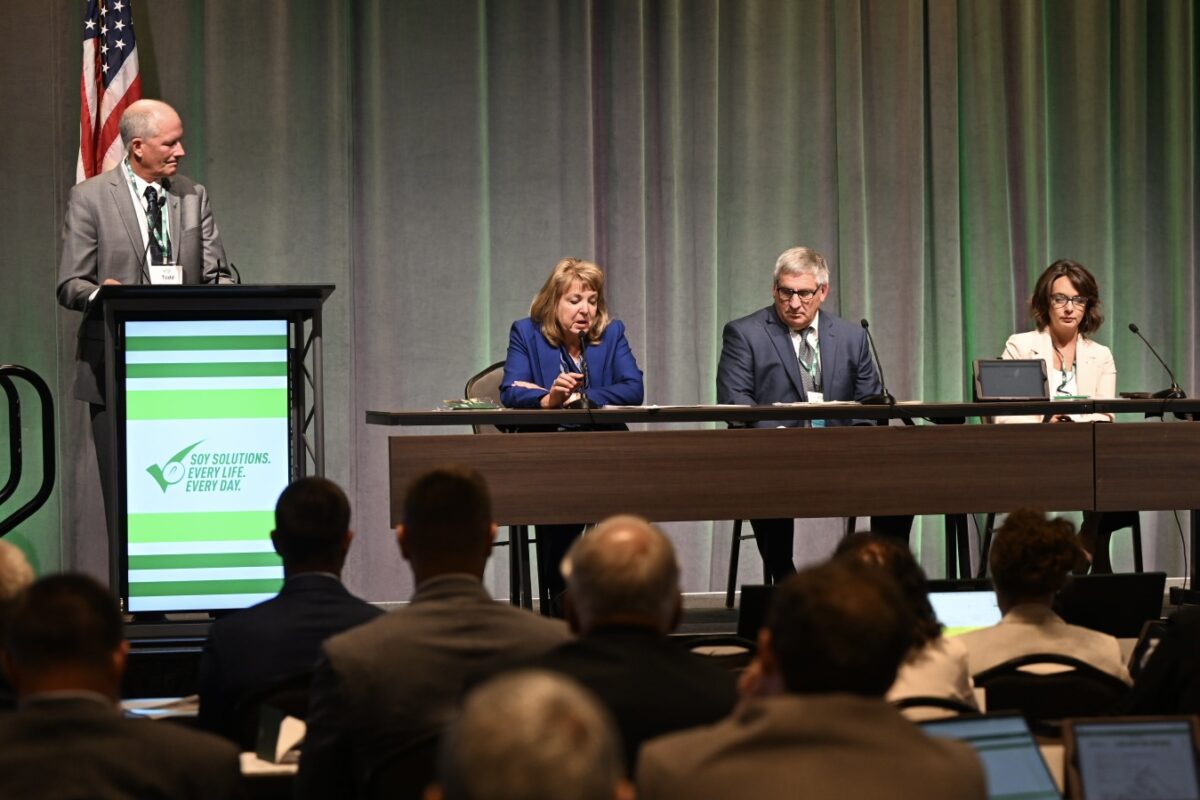Farmers Align with Value Chain to Address Land Use Change and Protect Natural Resources

Nancy Kavazanjian, a United Soybean Board farmer-leader from Wisconsin, served on a panel at the Land Use Change Summit and encouraged the value chain to “look at the farmer as your partner and bring us along the way” when it comes to understanding land use change that’s more representative of today’s farming practices.
ST. LOUIS (August 14, 2024) — A new Land Use Change Initiative (LUCI) is leading efforts to resolve inconsistencies in definitions, metrics and methodologies for quantifying land use change. Funded by the United Soybean Board (USB) in partnership with Carbon A List, this multistakeholder initiative seeks to unite every step of the value chain in developing a unified solution to these challenges. Farmers play an essential role in protecting our land’s natural resources through sustainable farming and conservation planning.
“Farmers have often been left out of conversations regarding land use change and its collective impact on agriculture. We weren’t at the table, so we had to build our own table through this land use change initiative,” said Steve Reinhard, USB Chair and Ohio farmer who presented keynote remarks at LUCI’s recent Land Use Change Summit. “North American agriculture and the half-million soybean farmers who represent 90 million acres can have a huge impact on climate solutions. Progress is a priority on our farm not only when it comes to conservation but improving land management. For example, the grids for monitoring our fields started at 5 acres, then dropped to 2.5 acres, and now we’re seeing it down to the acre and even half-acre to make input adjustments for soil health and crop productivity.”
LUCI started two years ago to proactively drive collaboration and advance sound science. The goal aims to achieve a better understanding of land use change that’s more representative of today’s farming practices, the role of grasslands in our agricultural system, and ensuring system resilience.
Examples of farmers’ commitment to land use change and sustainable farming include:
- Through LUCI, convening key players across the agriculture, environmental science, corporate sustainability, academia, and government sectors to coordinate land use calculations that preserve farmland and native and natural ecosystems.
- Spearheading Farmers for Soil Health in collaboration with the corn and pork commodity groups, and the National Fish and Wildlife Foundation, to provide a cost share and technical assistance to farmers in 20 states aiming to double cover crop acres to 30 million acres by 2030.
- Investing in research to enhance seed genetics that can withstand drought and flooding, in addition to using genomics to accelerate the development of new soybean varieties, improving soybean protein and amino acid composition.
- Researching and educating farmers on new biological products for pest management, fertilizer, and fungicides.
- Investing in communications and science translation to reach farmers and stakeholders across the value chain.
“Land use change is evolutionary, not revolutionary. Farmers are trying our best to do what we think is right for our land. And change is not always going to happen overnight, so please be patient with us. Look at the farmer as your partner and bring us along the way,” said Nancy Kavazanjian, USB director and Wisconsin farmer. “Not only are we losing grasslands, we’re losing productive farmland to urbanization and acres being converted to warehouses, residential developments, and wind and solar farms.”
David Wessel, USB director and Illinois farmer additionally shares, “Right now, it is difficult to compete with our worldwide competitors on production alone. A consistent land use change model would make for a more even playing field, giving U.S. products the advantage we need to gain market share in an environmentally friendly marketplace.”
LUCI recently hosted its inaugural in-person Land Use Change Summit at McDonald’s International Headquarters in Chicago, sponsored by USB, McDonald’s, Carbon A List and Fulton Market Group. Gathering nearly 100 experts across the food and agriculture value chain, the summit set out to accomplish three goals: 1) find common ground 2) set a strategic course, and 3) prepare to engage. Several presentations, panels, breakouts and even remarks from Robert Bonnie, Under Secretary for Farm Production and Conservation at the U.S. Department of Agriculture, grounded this group on the task at hand. LUCI participants narrowed consensus on definitions, consolidated data sources, increased the accuracy of land use change estimation, and chartered next steps for a path forward.
To receive updates or get involved, visit the Land Use Change Initiative webpage where you can find a white paper describing critical issues and gaps, and identifies where the opportunities exist for implementing change, in addition to a primer report and proceedings report prepared for LUCI’s workshop sessions.
About United Soybean Board: United Soybean Board’s 77 volunteer farmer-leaders work on behalf of all U.S. soybean farmers to achieve maximum value for their soy checkoff investments. These volunteers create value by investing in research, education, and promotion with the vision to deliver sustainable soy solutions to every life, every day, across the three priority areas of Infrastructure & Connectivity, Health & Nutrition, and Innovation & Technology. As stipulated in the federal Soybean Promotion, Research and Consumer Information Act, the USDA Agricultural Marketing Service has oversight responsibilities for USB and the soy checkoff. For more information on the United Soybean Board, visit unitedsoybean.org.
About LUCI: The Land Use Change Initiative (LUCI) is a collaborative effort funded by the United Soybean Board. LUCI aims to develop unified solutions to the inconsistent land use change estimates and definitions, impacting crucial resource management decisions. By bringing together a diverse range of stakeholders, LUCI strives to enhance the understanding and management of land use change.
###



